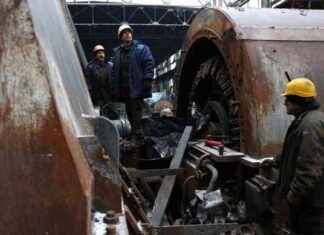My heels hang over the cliff, both hands grip the rope, I look over my shoulder at the turquoise sea. Boats chug along 40 meters below me, vacationers wave and cheer from their stands bobbing in the water.
I breathe deeply, concentrating on the backward hop over the cliff edge, on the hand grips when sliding down the rope in a free-floating manner. Don’t mess anything up now. It is the last and deepest abseiling, the worthy finale of this tour.
For five days she took us along the Golfo di Orosei, through the wilderness of a hundreds of meters high cliff, a natural world heritage site in eastern Sardinia. She became world famous as Selvaggio Blu. Today it is considered one of the most beautiful trekking routes in Europe. And perhaps the hardest.
Just finding the route is difficult. “The Selvaggio Blu is not a fixed path,” says mountain guide Ivan Pegorari. There are many variants, but they all follow the same philosophy: to walk as close to the sea as possible. “I think this is the wildest coast on the Mediterranean,” says Pegorari. “For 60 kilometers there is nothing but nature.”
Probably nobody knows the Selvaggio Blu better than Pegorari. The mountain guide from Lombardy is in his late forties in the sinewy body of a mid-twenties. He outshines his missing hair with a broad smile.
He has been leading guests on this tour for 19 years, and they are all immortalized in his diary: more than 700 names. “The Selvaggio Blu,” he says, “is more than a hike.” He is the love of his life as a mountain guide.
He found her in a hut on the beach. More precisely, in a handwritten book. There he read about a route along the cliffs, half hike, half scramble, spiced with a good pinch of abseiling. And he found copies of maps.
“In May 1999 I rented a small boat. I drove around the bays – and thought: Mamma Mia! “He hid water bottles on the beaches, then he ran without a tent. “We slept in caves or under the stars.”
Nowadays, the trail can be booked with many mountain tour operators, including a guide and daily supply boat. Going out on your own would be extremely reckless – if only because there are hardly any water sources in the limestone mountains of the Supramonte.
The starting point, however, seems moderately wild: a parking lot below the village of Baunei, crowded with cars and vans. Most come here to climb Pedra Longa, a rock pyramid overlooking the sea.
Our harnesses and helmets stay in the backpack for the time being. We walk through the maquis on a sandy path. Holm oaks cling to karst rocks, red berries hang from mastic bushes. Metallic blue lizards scurry in cushions of wild rosemary.
The higher we climb, the denser the forest becomes. Soon there is no path across country, in a clearing there are shepherds’ shelters made of juniper trunks. We balance over rubble, duck under branches, my backpack keeps getting caught. Twigs scrape, thorns get caught in shirt and pants.
“Two hikers disappeared last summer,” says Ivan Pegorari. “They have not been found to this day. If you get lost here, you’re done for.”
The long descent ends at a narrow fjord. Everyone rips off their sweaty shirts and sinks into the clear, still water with sighs of delight. We dive, snort, float backwards between pale rock walls and look up at the overhanging bushes.
This fjord is called Porto Pedrosu, coal used to be loaded here. Until a few decades ago, charcoal burners felled holm oaks on this coast and charred them in roughly brick piles. “All the paths that lead down were made by charcoal burners,” explains Pegorari, “all that run at the same level by shepherds.”
When the supply boat comes in, everyone pitches in, hauling provisions, tents, bags with sleeping bags and fresh laundry ashore. And Pegorari’s thick mattress. “I’m here for four weeks straight this summer,” he says, smiling and shrugging his shoulders.
Hikers used to sleep on the beach, although that was forbidden in the national park even then. But there were very few. But in 2011, the Selvaggio Blu suddenly became famous when TV stations and the magazine of the Italian Alpine Club CAI reported. “Some days 150 people camped here,” says Pegorari. “It was a mess.”
Together with other guides, he proposed rules to the authorities. Six years ago, the national park authority set up campgrounds, each of which can accommodate a maximum of 40 hikers per day. The term campsite is perhaps a bit high. In fact, the undergrowth was cleared and stones cleared on plots scattered in the forest. The further I get from the sea, the stronger it smells of goat.
Nevertheless, the mood is great, at the latest when the guides shovel pasta onto the plates. There is also wine from the plastic bottle. And for dessert, Pegorari unpacks his guitar. While the northern Italians of the other group of hikers clap and sing at the top of their lungs, the Germans smile shyly and pour themselves Mirto, the Sardinian mirten liqueur. Or even flee into the tent. Well, it’s the first night.
Of course, the hangovers won in the morning. We climb up through dense bushes, there is no wind, stuffy, hot. “I’ve never sweated so much,” says Martina from Munich, who is hiking with us. “But I don’t go to the sauna either.”
A few pigs dart off the path into the forest, shaggy goats stare at us from a safe distance. Faint blue lines can still be seen on some rocks, the original markings. Today, stones show the way, placed in forked branches or spiked on twigs.
We pause at a cliff that falls hundreds of meters straight into the sea. The breeze and shade are a treat, the view along the cliffs and down to shades of turquoise to dark blue is fantastic – and gets even better when we step onto a rocky outcrop shortly after.
Far below us lies Cala Goloritze, the dream bay that has been photographed millions of times: stepped, green-speckled rock walls, a fleet of white boats in the turquoise, directly above the beach the colossal rock needle Aguglia, against whose limestone walls climbers measure themselves.
As we descend, a column of vacationers in swimming trunks and bikinis comes towards us, the beach is crowded like an open-air pool. But the gravel is white and fine, the sea is clear and the backdrop is gigantic.
In the late afternoon, the day trippers leave the bay. Of course, it would be terrific to simply roll out the sleeping pad and stay here. But if a police patrol boat stops by, says Pegorari, everyone pays a fine of more than 200 euros.
A motorboat therefore chauffeurs us to the next bay. And the Cala Mariolu is a very passable substitute: a double beach under a cliff, divided by a cape. The excursion boats left long ago, the bay is ours alone.
A Sardinian and his teenage son are still selling beer in a kiosk. Is it cold? The pot-bellied son gets a few cans from the fridge, points silently to the ice cream on the edge and nods.
Of course, no beer has ever tasted better. But too many doses would be dangerous now. Because after the pasta feast we still have to climb to the campsite on top of the cliffs – over narrow ledges and wobbly wooden ladders. With a headlamp.
By the next morning at the latest, we can already guess how adventurous the tour is going to be. We have to turn back at a scree slope, a rock fall has torn the path away. “The path changes every year,” says Pegorari. “It rains a lot here in winter.” Unlike official hiking trails, the Selvaggio Blu is not maintained.
Without a mountain guide, it would be tricky now at the latest. And the key point of the day is yet to come: the first abseil. Step by step I feel my way backwards towards the abyss. One hand holds the rope hanging from a gnarled trunk of juniper. The other pushes the Prusik sling over the rope. She would pull herself if she fell. So even if I let go of the rope, nothing can happen.
Nevertheless, it takes some effort to hop backwards over the edge and slowly, hand by hand, slide down into the depths. Soon my feet can’t find any footing, I’m floating, turning without control, the carabiners are getting hot. Keep calm, I admonish myself, carry on, hand for hand.
It hardly looks elegant for my fellow hikers who are waiting. But the next day I get plenty of opportunities to improve technique and style. Seven abseilers are waiting, the highest at the end.
Hooking and securing is now quicker, no more hectic tangling. And the sinking feeling, the anxious nervousness give way to sheer anticipation. With a whoop we whirr downwards, almost routinely.
So that we don’t get bored, the guides lead into a cave. Thousands pierce the limestone mountains of the Supramonte. We climb backwards down the dark gorge on a simple rope, the cones of light from the headlamps flicker over the stalactites. We crawl on through waist-high crevices, cave by cave – until we see light again. And the sea.
Perhaps the most beautiful of all bays awaits as a reward: Cala Biriola. The young Italians do somersaults from a rock arch into the sea. And when Ivan Pegorari strums his guitar one last time, even the Germans sing along.
“I saw the Milky Way as clearly as only in the mountains of Nepal or Peru,” says the Selvaggio veteran, sipping the Mirto. “If then a red moon rises over the sea – phew.”
Arrival: There are direct flights to Cagliari from several German cities. Bus line 103 runs several times a day to the Tortoli Fra Locci stop, from where it continues with line 301 to the mountain village of Baunei. Alternatively, travel by train to Genoa or Livorno and take the ferry to Olbia. From there, bus line 514 goes to Nuoro and bus line 303 to Baunei.
When to go: The best months are May and June, when the maquis is in bloom, and September and October, when the sea is still warm. In midsummer it is too hot for hiking, in winter it rains a lot.
Guides and organizers: Several mountain travel organizers offer the Selvaggio Blu including a mountain guide and daily supply by boats, for example the Oase Alpincenter (oase-alpin.de). Italian-language tours with Ivan Pegorari can be booked at valmalencoalpina.com.
Literature: The Rother hiking guide Sardinia describes several day tours that are part of the Selvaggio Blu (16.90 euros, rother.de).
Information about the Selvaggio Blu is also available in a free English travel guide on the Internet.
More information: sardegnaturismo.it/en
Hiking has been experiencing a real boom for a number of years, including among younger people. But hiking can also be dangerous, especially if you want to climb the mountains with the wrong shoes. The right preparation is everything here, too.
Source: WELT/ Peter Haentjes








